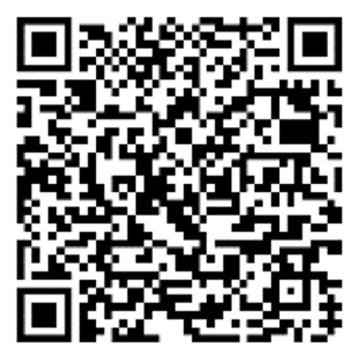Gestión 2022
5.3 Social Management
S - Helping society to prosper
5.3.1. Connectivity for Digital Growth and Innovation
Telefónica Movistar’s study “The importance of human connections”.
- 77% of respondents believe that technologies con helped them to maintain quality relationships and 68% think that social media play an especially important role in them.
- For 81% of the respondents belonging to generation Z (18 to 25 years old) technology supports their relationships, as it is for 79% of the Y (26 to 36 years old) and X (36 to 50 years old), while for the Baby boomers (51 to 65 years old) it is 71%, showing that, despite the generational breach, technology preserves a significant role.
- “Being connected” is meant as something positive for 67% of the participants, as it allows them to socialize, connect, share experiences, interests and become part of a community. Likewise, the main specific actions that make this connection possible are spending time with family and friends, connecting to social networks, being available at all times from any device, listening to music, among others..
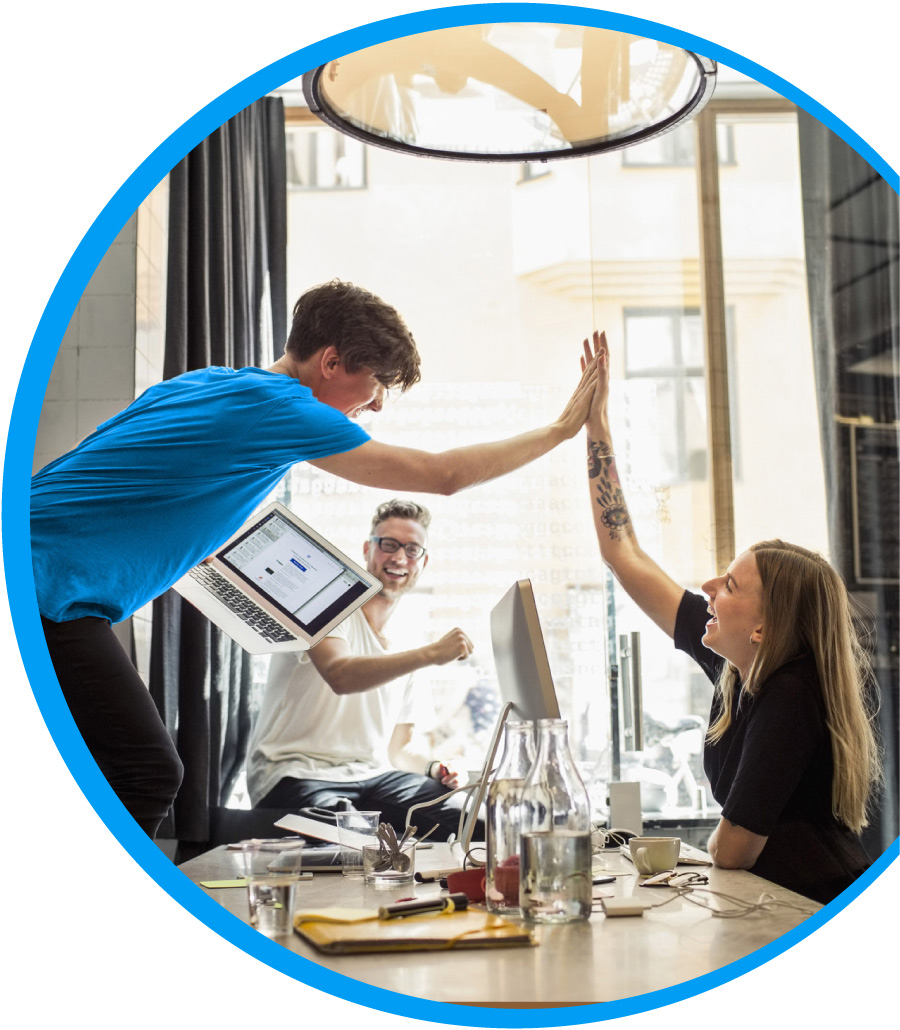
Digital growth
La crisis sanitaria y económica mundial provocada The global health and economic crisis triggered by COVID-19 has exposed the need to increase the pace of transformation of economies and social models to ensure recovery and return to the path of prosperity. In the face of this, digitalization is a key factor to make this transition possible and ensure that it is inclusive, fair and sustainable. The commitment is to place technology at the service of people and protection of the planet, reducing environmental impact and offering customers solutions that enable them to operate more efficiently and sustainably.
In this effort, the deployment of fiber optics in
Colombia is crucial. Regulation must change to a
flexible approach with lower distribution charges,
promoting new deployment models, and placing priority
on negotiation over forced sharing, which will allow
for a leap in connectivity in the next few
years.
In 2022, Telefónica Colombia and the investment firm KKR, after receiving the appropriate regulatory authorizations, completed the completion of the transaction by virtue of which a separate company was established that will be responsible for implementing the largest neutral fiber-to-thehome (FTTH) network in Colombia, from which all operators in the market will be able to benefit.
In 2022 and thanks to the partnerships, the Company accepted the challenge of achieving one of the largest fiber optic network deployments in Colombia, setting a company goal of 1.3 million new homes covered by the FTTH network in about 38 cities in the country. The target was surpassed, reaching not only to 1.4 million households, but also placing Movistar as the company with the largest expansion in Colombia and also in the entire HISPAM region.
With this fiber optic network expansion plan, it was able to participate in the country’s economic development thanks to an investment of nearly COP 302.4 billion and the employment of over 5000 jobs, making it possible to build the best-fixed network, which by the end of 2022 had already reached 3.6 million homes benefiting from FTTH technology. In 2022, it launched fiber optics in Manizales, Florencia, Barrancabermeja, and Pereira.
Regarding 4G, in the year 2022 more than 2,000 solutions were implemented between operators and new sites in the 70 main municipalities of the country, besides the expansion of carriers from 5 to 10 MHz in the 850 and 1900 MHz bands in the 10 major cities (Bogotá D.C., Medellín, Cali, Bucaramanga, Barranquilla, Cartagena, Cúcuta, Ibagué, Neiva and Pasto) was completed. These network deployments improved coverage and capacity to support the 40 percent increase in mobile network traffic.
The year 2022 was a challenging for network operation; changes such as the return to face-to-face operation after the pandemic caused the traffic to return to its usual location, the entry of the KKR co-investor to FTTH operation, the winter season that affected the national territory and extended the recovery times of failures, hurricane Julia impacted the island of San Andres, this, together with the lack of electricity flow in some regions and the increase in infrastructure thefts, put pressure on the stability of the network, which was successfully resolved by preserving an average availability of over 99.95% throughout the network, 99.96% in the basic line, while for Broadband and FTTH, 99.98% availability was achieved, and in the mobile access network 99.93% was measured with the parameters of the regulation in force
Women in Network
By the end of 2022, the percentage of women in the technical staff of third parties increased to 9.1%. The implementation of this Program is supported by nine Partners or collaborating companies. It was achieved a reduction in female operational retirements from 21% to 8% in the comparative periods 2021 and 2022, respectively.
The program Women in Network received the recognition of good practices that support the Sustainable Development Goals, awarded by the Pacto Global Red Colombia and the Bogotá Chamber of Commerce, and it won the Ingenio 2022 Awards (Women For TIC – WO4TIC category) for supporting the development of women’s talent in the software and IT industry.

Other significant cases:
- Social Impact in the Territory of Urabá with connectivity in rural schools in the area, which did not benefit from this service prior to October 2022.
- Implementation of the “Finca+Segura” Project, in partnership with the Department of Antioquia, connecting at least 100 Farms in the Southwest of the Department. With this measure, it reduced the number of crimes by around 41% (data from the Governor’s Department of Antioquia in 2022).
Innovation
The Company takes innovation as a driver of transformation. The Innovation Management is defined by three focus areas.
- More or new revenues through improvements in processes, new products or new services.
- Areas for innovation to promote talent motivation as well as talent retention.
- Areas of interaction with partners on multiple levels to strengthen the ecosystem with creative solutions to challenges that foster sustainable development. Besides the establishment of learning environments.
Within this framework,
Wayra is the investment, innovation and venture
support arm of Telefónica Movistar in Hispanic
America, and by 2022 the amounts of startups are as
follows:
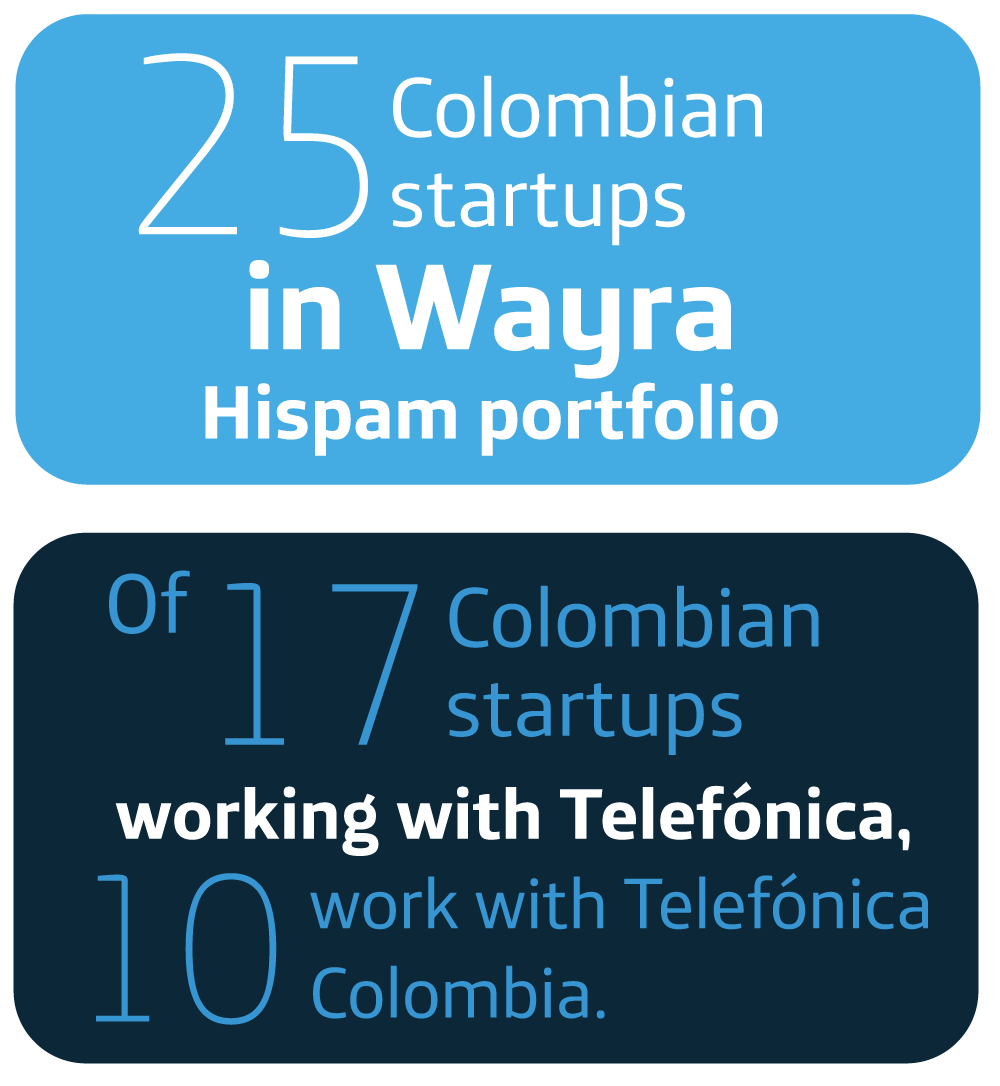
With the purpose of continuing to support innovation in Colombia, Wayra Labs was launched in 2022, the first 5G and IoT laboratory in the country, a place with the latest generation of 5G technology that, as part of its strategy to transform its Hub into a technology laboratory, now offers startups, educational institutions and companies the opportunity to develop new and innovative 5G applications for consumers and industry in the country.
Wayra Labs is the first in Colombia of its category and has complete technical equipment and specialized training. 5G comes to Wayra Labs with diverse opportunities for the development of cases in the field of Smart cities, Industry 4.0, Massive-Broadband-Critical IoT having as main feature the massive connections that facilitate the deployment of thousands of sensors for the management of energy, pollution, traffic, among others, the inclusion of high speeds in applications such as drones, intelligent transportation systems, immersive virtual and enhanced reality experiences and low power consumption for the automation of smart grids, collaborative robotics and mission-critical systems.
Moreover, Wayra supported Movistar in the launch of the ‘Innovation Academy’ for entrepreneurs of small and mediumsized businesses in Argentina, Colombia, Chile, Peru, Mexico, Ecuador, Venezuela and Uruguay. This Academy offers a library of free and open courses that provide knowledge, tools and experiences to manage, empower and expand businesses, as well as the possibility to register for free.
In addition, Telefónica is one of the companies participating in Corporate Impact Venturing Latin America & The Caribbean (CIV LAC), an initiative led by IDB Lab and IDB Invest, together with Wayra Hispam. This initiative seeks to connect large Latin American companies and organizations with technological ventures (startups) that have solutions to cross-cutting issues in the region, such as social inclusion, education, support for MSMEs and environmental protection.
5.3.2 Human capital
(GRI Content 2-7, 2-8)
Focusing on people at the center of the strategy, the Company is committed to maximize the potential of its employees and increase their motivation as the drivers of change and sustainable growth. The enthusiasm and commitment to Telefónica’s purpose and values are key to achieving the company’s objectives. In 2022, the Company continued to be a significant employer in the country. In the six regions (Headquarters, Bogota, Caribbean, North-West, East and South) the Company had a commitment of 6,197 *Does not include Foundation Payroll * Excludes interns and temporary workers employees, 48% women, and 52% men. There was a significant increase in temporary employees compared to 2021 (693 in 2021 vs. 1,042 in 2022), mostly related to temporary work positions for fiber sales in the street. Note that for all the data in this chapter are based on the Company’s headcount closing as of december 31, 2022. Income and turnover indicators do not include temporary positions or internships.

Hiring and turnover
Total number and rate of new employee hires during 2022 by age group, gender, and region. (GRI 401-1).
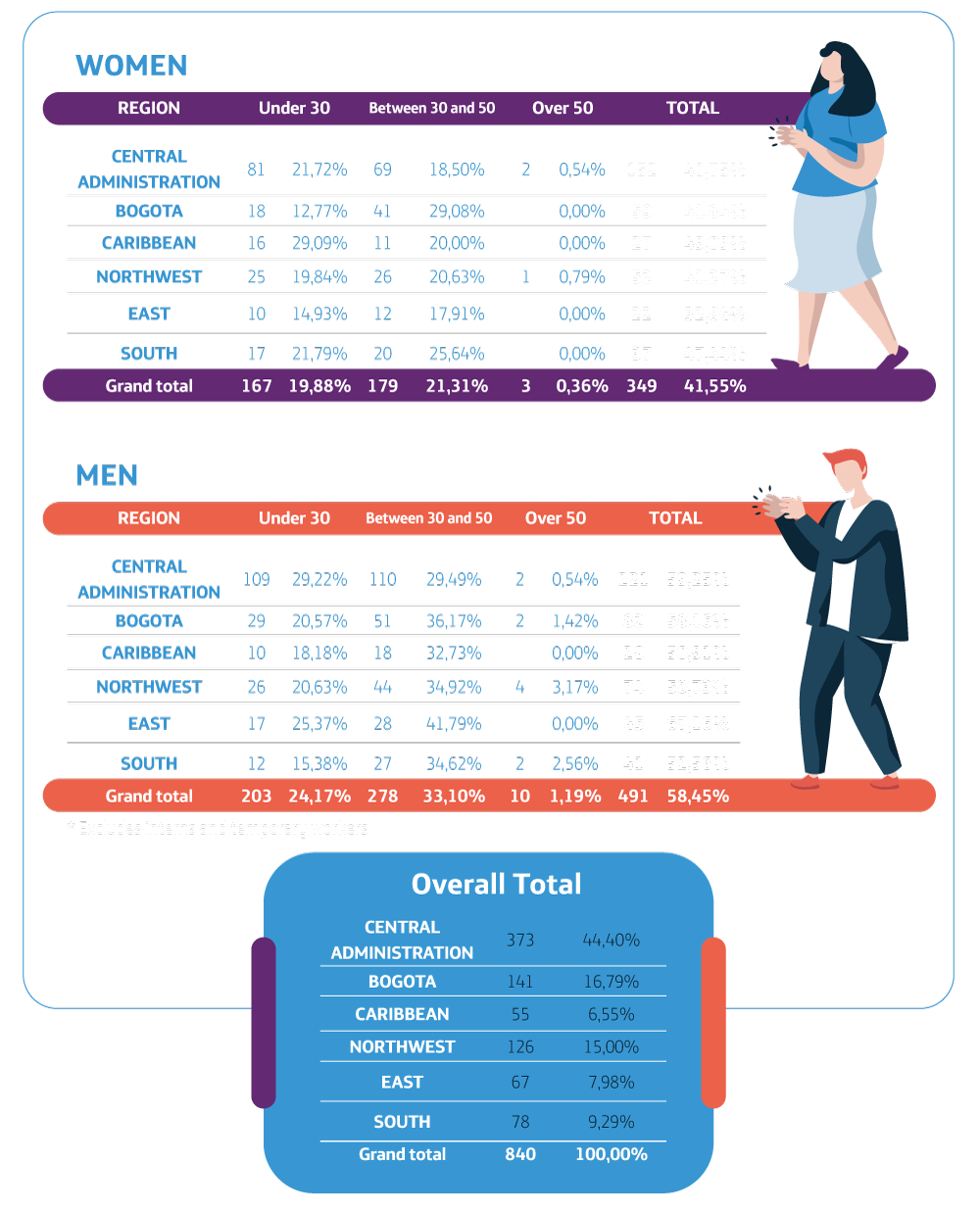
Total employees and turnover rate during 2022 by age group, gender and region.

Diversity, Equity and Inclusion
(GRI Content 406-1)
The Company is convinced that organizations
reflect the people who work in them.
Therefore, managing Diversity, Equity, and Inclusion (DEI) is
critical in the Company’s Responsible Business
Plan.
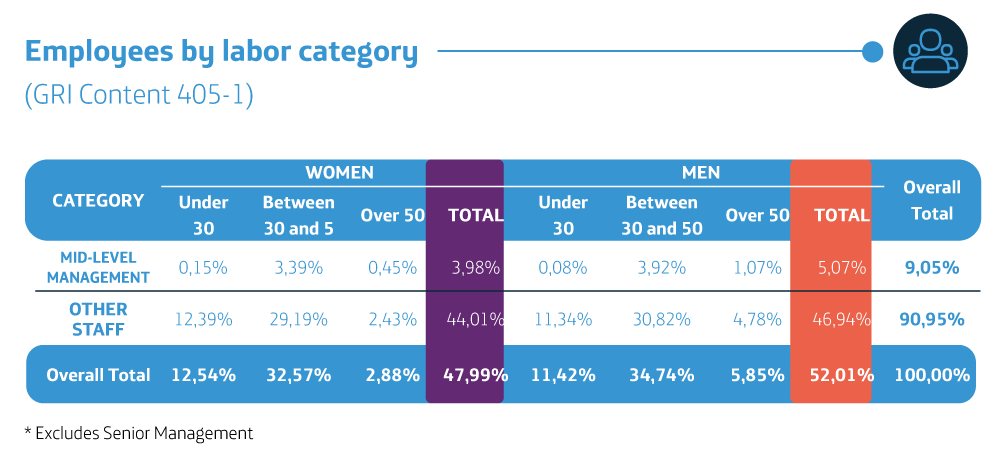

The Board of Directors agreed to set and govern the principles that ensure equal opportunities and diversity within the Telefónica Group, and reaffirmed this commitment through a global Policy applicable to all the companies part of the group, whose objective is to ensure non-discriminatory, fair and impartial treatment in all areas of the organization, and they are strongly opposed to any conduct or practice associated with prejudice based on, among others, nationality, ethnic origin, skin color, marital status, family responsible, religion, age, disability, social status, political opinion, serological and health status, gender, sex, sexual orientation, identity and gender expression.
In order to strengthen a culture of diversity, equity and inclusion, the Company has adopted a strategy with the following focus areas:
1. GENDER EQUALITY:
The initiatives are focused on reducing the gap between men and women and promoting equality.
- Execution of a Recruitment and Selection process with a gender focus, which sets clear and impartial methods, giving equal opportunity to all personnel. One of the best practices that seek to generate gender balance in leadership positions is to ensure that at least one woman is included in the final shortlist. In addition, in 2022 was held an inclusive interview and communication workshop, preparing recruiting teams and assuring that these processes are free of bias and ensuring that the publication of vacancies is free of discriminatory criteria based on gender, age, marital status, appearance, height, weight, ethnicity, disability status, among others.
- Implementation of an internal and external communication manual for the promotion of inclusive and non-sexist language. This tool has allowed us to gauge the staff in charge (communication teams and agencies), ensuring that brand communication is inclusive and appealing to all the people who are part of this Company.
- With Futura, Hispam’s women’s leadership program, we seek to promote women’s leadership within the organization, achieving the acquisition of different skills that will enable them to face new challenges in positions of higher level and responsibility. Futura provides training in 8 modules that allow participants to enhance their skills as leaders, obtain tools to “break glass ceilings” and prepare themselves to face the challenges that new positions within the organization entail. Workshops such as: Unconscious Biases, Personal Leadership, Negotiation, Communication and Networking, among others, are part of the program’s training itinerary. In 2022, the program began with 231 women in its second edition, including 66 from Colombia.
- The company has set goals to leverage the promotion of female leadership in higher level positions. By the end of 2022, the Company reached 39.2% of women in leadership positions, it achieved 37.5% of women in management positions (target of 32%) and 41.18% of women in pre-management positions (target of 41.30%).
- Implementation of Spaces Free from Sexual Harassment (ELSA, for the Spanish original) for companies. Definition and launch of a structured work plan focused on eradicating situations associated with sexual harassment. This plan has been carried out with the support of Genderlab and the Inter-American Development Bank. This tool, based on algorithms and artificial intelligence, has made it possible to recognize and take action against sexual harassment in the workplace. Based on the results of the 2021 measurement, the Company was recognized for its prevention system for sexual harassment situations and by 2022 was recognized as an ELSA Pioneer company, for all the work deployed to promote spaces free of sexual harassment.

2. GENERATIONAL: implementation of actions and initiatives aimed to engage people from diverse generations in the organization and launch of talent engagement programs that open the doors to people under 35 years old by providing them with the necessary tools and support to empower in the new digital world through initiatives that promote their engagement in the organization. By the end of 2022, 40.78% of the workforce were young people under 35 years old, exceeding the established goal of 39.90%.
-
Implementation of Movistar Generation (GM), a program that aims to connect with young people and challenge to boost
their top talent in the organization, through
a learning ecosystem that mixes on the job
training and skills development to meet the
demands of the digital transformation of the
business.
This program has three specific elements:
- Project: participants have the responsibility of a project with a 1-year term and report on progress after 4 months in workshops where the leaders participate, with the objective of making their work and profiles more visible.
- Training: a learning ecosystem to develop soft and digital skills, getting monthly training for 1 year.
- Application: after 6 months in the organization, GM participants can apply for open vacancies in the company.
- Annually, the Company is measured by Employers For Youth, a quantitative study that seeks to recognize and understand the expectations and performance of young professionals, as well as the most valued attributes in their companies. For 2022, Telefónica Colombia ranked 18th in the country, and is the first organization in the sector for its practices of inclusion and youth development.

3. LGBTQI+ COMMUNITY3: The Company develops safe workplaces for members of the LGBTIQ+ community by promoting respect and nondiscrimination.
- Creation of extensive benefits for the LGBTIQ+ community (wedding time, mourning time, homoparental leave, school leaves, among others), promoting their use through a communication campaign.
- Launching of Sostener (support network of people from the LGBTIQ+ community, family members and Partners). This community generates spaces for awareness, knowledge and conversation on topics such as diverse orientations and identities, suicide prevention, intersectionality, non-binary population, trans population, among others.
- Participation in Presente, a diagnosis focused on identifying the best practices and internal and external progress of the Company regarding the inclusion of members of the LGBTIQ+ community. This initiative carried out in 2022 allows us to identify progress on the LGBTIQ+ front.
4. PEOPLE WITH DISABILITIES: incorporation of people with disabilities into the workforce and accessible customer service (see Chapter 5.4.1. Having the customer at the heart of what is done).
- Launching of the manual for interaction of people with disabilities, a guide that provides tips to remove the daily challenges associated with the interaction of people with disabilities.
- En 2022 la Compañía contó con 17 empleados en plantilla con certificado de discapacidad.
It is important to highlight that the organization has a “Global Diversity Council” and a Local Diversity Council, where all these DEI actions, programs and initiatives are designed, implemented and monitored.
In addition, we have transversal initiatives such as Diverstars, a program launched in August 2022 that invites employees to be multipliers of knowledge on different topics related to diversity. It is not only about taking the concept of diversity and making it part of their daily discourse, but also about promoting a culture of diversity, equity and inclusion through example.
Finally, we have created a community hosted in Workplace with more than 4,500 personnel called “Diversaliad@s” where we share actions, communication, information and workshops to generate learning and awareness of diversity in general and in its 5 work axes.
Furthermore, aligned with the Responsible Business Principles (we guarantee the right of our employees to belong to the union organization that represents them and we do not tolerate any type of retaliation or hostile action towards those employees who participate in union activities) and with the third Principle of the Global Compact (companies should support freedom of association and the effective recognition of the right to collective bargaining), by 2022, 2% of the total number of employees were covered by collective bargaining agreements; it is relevant to note that the Company determines the labor and contractual conditions of employees affiliated to the union organization, as well as those who are not, in accordance with the provisions of the Law. There is an Arbitration award dated May 3, 2016, and it only has an impact on workers affiliated to the union organization “Union of Communications Workers” – (USTC) (GRI Content 2-30).
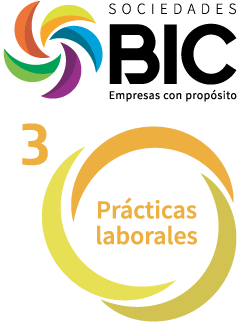
Salary remuneration
(GRI Content 2-19, 2-20 and 2-21)
For
Telefónica Colombia it is of great relevance to have
a solid and consistent salary structure that
recognizes individual performance, values the
importance and impact of each position within the
organization and is competitive in the national
salary market. This structure is based on a
systematic process that covers from the description
to the salary allocation for the organization’s
positions, as well as the constant comparison with
the market to determine the competitiveness of
salaries. This process is performed based on the
position and its valuation and impact on the
organization, not on its people, so gender is not a
critical factor in the calculation of the salary
assignment, nor to evaluate its performance in the
market.
Salary Structure
The Company has a structure based on job levels as a result of an appraisal, which covers a range of 12 different levels, grouping the non-management positions of the organization. Each level is compared for internal equity and external competitiveness to determine the corresponding salary conditions, thus avoiding biases due to salary allocations for higher levels. Consequently, the remuneration defined for the occupants of the positions correspond to the functions, responsibilities and their impact on the organization; therefore, there is no comparison in the salary allocation of a
Pre-Management level, compared to the average of the organization, considering that more than 40% of the employees represent the lower levels of this scale (4 to 7).
Compensation for all levels of the organization is set based on criteria of external competitiveness (salary market), internal equity (comparison by levels and families of positions) and the economic context of the organization. According to the nature of the functions of each position, a compensation mix is established that includes fixed salary, commissions and annual bonus for organizational results.

- Fixed Monthly Salary: it is established that no direct employee has less than the minimum legal salary in force each year.
- Variable Salary (commissions): applies to employees who perform commercial sales or customer service activities and whose goals are defined and measured by the Commercial Planning area.
- Annual Bonus: Applies to direct employees of the organization and is typically assigned to non- Commercial positions. Its percentage allocation varies according to the impact of the role on the achievement of business objectives. The higher the level of the position, the higher the percentage allocation. The amounts assigned vary from 50% to 100% of the salary offered to the candidate and are subject to a minimum permanence of 1 year in the organization.
To measure the results of each of Telefónica’s operations, year after year, a number of fundamental axes are set with a specific value that is measured at the end of each year to determine the percentage of bonus payments based on results. For 2022 the KPIs were: Net Promoter Score (NPS), Scope I and II issues, and percentage of female managers; each with a share of 8%, 7% and 5% respectively.
In 2022, the annual total compensation ratio of the highest paid worker vs. average employee was 830.7%.
En 2022 la ratio de compensación total anual del trabajador(a) mejor pagado vs. media de empleados(as) fue de 830,7%. Adicionalmente, el porcentaje de incremento mejor pagado fue de 6,3% y el promedio de 5,6%. Para estos indicadores se tuvo en cuenta la planta sin becarios, Jóvenes Profesionales, Fundación Telefónica Movistar y Directivos.
Adicionalmente, la Compañía cuenta con el Sello Oro Equipare, y tiene un plan de acción para el cierre de las brechas de género identificadas en diagnósticos anuales de las brechas salariales (GRI Contenido 405-2):
Additionally, the percentage of the highest paid increase was 6.3% and the average was 5.6%. For these indicators, we considered the plant without internships, Young Professionals, Fundación Telefónica Movistar and Executives.
Adicionalmente, la Compañía cuenta con el Sello Oro In addition, the Company has the Equipare Gold Seal, and has an action plan for closing the gender gaps identified in annual salary gap diagnoses (GRI Content 405-2)

(GRI Content 401-2)
Note that standard benefits for full-time employees of the organization, but which are not provided to part-time or temporary employees, includes:
Disability assistance:
for common cause disabilities, the Company provides the benefit equivalent to 33.33% of the base liquidation income in addition to the value of the disability recognized by the EPS for the first 90 days and 50% for the following 90 days, so that the employee receives a total payment of 100% of his/her income, only during the first 180 days of disability. The Company may at any time not recognize and/or modify the percentage of the benefit indicated above, if it so deems, without this being an acquired right.
Life Insurance:
the purpose of this insurance is to cover the employee’s death or total and permanent disability. 100% of the value of this benefit is assumed by the Company and is an extra-legal benefit offered by the Company from the initial moment of the contractual relationship.
*Does not apply to part-time or temporary employees.
Paid Time Off (excluding those stipulated by law):
Maternity Leave Extension: 2 additional weeks (14 calendar days) are granted in addition to those established by law (18 weeks – 126 calendar days), thus extending the maternity leave determined by labor regulations, for a total of 20 weeks (140 calendar days). The same applies to adoptive mothers
Paternity Leave Extension: 6 additional working days are granted in addition to the paternity leave granted by law (8 working days), thus extending the paternity leave established in the labor regulations, for a total of 14 working days. The same applies to adoptive parents
Gradual return or soft landing: As an additional benefit, after the father and/or mother returns from maternity, paternity or homoparental leave, as the case may be, he/she may gradually return to work, receiving a reduction of one hour of his/her daily workday for a period of 30 calendar days, in coordination previously with the direct supervisor. This process also applies to adoptive mothers/parents.
School Leave: permission for employees regardless of gender who have children of school age, so that they can be absent two half days per year to attend activities related to the celebration of family events organized by educational institutions. Likewise, employees, regardless of gender, are granted three hours of leave per two-month period to receive their children’s report cards, which show their children’s performance.
Wedding time: benefit that allows to the employee to take four (4) days of paid leave to attend to the details of their wedding or go on a honeymoon without having to use another benefit, including same-sex couples.
Domestic calamity leave: is entitled to paid leave for an event considered serious that may affect the normal development of daily activities, in which fundamental rights of significant importance in the personal or family life of the employee may be threatened.
Miscarriage or stillbirth leave: if the partner of one of these (spouse or permanent partner, including couples formed by two women), during the course of her pregnancy suffers a miscarriage or premature stillbirth, is granted two (2) weeks of paid leave.
Homoparental leave: paid leave for those who are in a same-sex relationship and whose partners give birth to or adopt a minor. Whoever indicates to have the primary care of the minor, will have an equivalent to what is defined as maternity leave. That is, twenty (20) weeks (140 calendar days) or twenty-two (22) weeks (154 calendar days) in multiple births. Whoever indicates to have the secondary care of the child, will have an equivalent to what is defined as paternity leave. That is to say, he/she will enjoy a paid leave of fourteen (14) working days.

Well-being, teleworking and work-life balance
Two benefit programs are available to the Company’s employees:
Benefits UNO
On one side, Benefits UNO is an annual program that allows all direct personnel of the organization, including SENA trainees and internship students, to schedule credits and enjoy the benefits they want, according to their needs, preferences, and interests. They can choose between full days and half days to unwind and find a balance between personal, family, and work life.
In 2022, we were able to promote a culture of greater use of time-based benefits, increasing their adoption by 4.6%, from 59.2% in 2021 to 63.8% in 2022.
In addition, as of december 2022, a total of 91.92% of personnel planned at least one benefit and 63.21% planned at least 3 benefits, which is equivalent to 60% of the benefits
Momentos Movistar
On the other side, Momentos Movistar is a portfolio of activities and fun diverse experiences for the personnel, scheduled according to their preferences and interests, under a system of redemption of “credits”. The Company has seven categories to enjoy each of them when desired: rest, culture, sports activities, gastronomy, recreation, online classes and tangible products. It also offers the option of sharing with co-workers and family, according to the city in which is located.
As of december 2022, at least 88% of personnel enjoyed at least one experience during the year, 87% of women and 88% of men. This includes both experiences and tangible products of the portal, as well as activities in the area.
Flexible working hours and teleworking
The Company works under a hybrid model, in which employees come to the offices twice a week and work from home the other three days. This, with the purpose of taking advantage of the virtual world as well as the on-site world.
In addition to this, there are a number of benefits related to time and flexibility in the workday.
From Monday to Thursday employees may choose to work any of the following schedules established by the company:

The purpose of this benefit is for each personnel to choose the schedule in which they wish to work, according to their likes, needs and preferences. The decision should always be discussed with the leader and the members of the team, to ensure that everyone is aligned, respect the schedule of each member and promote digital wellbeing.
Moreover, there is a “Friday off”, which means that all Fridays of the year are shorter. The personnel has the benefit of working from 8:00 a.m. to 2:00 p.m. full-time. This benefit does not include the recovery of hours nor salary discount and applies according to the role.
Employees whose roles are not covered by this measure may enjoy the “Two Days for Friday Schedule” benefit through Success Factors (SSFF), through which they have access to two consecutive days of paid time off, in addition to their vacation period.
Furthermore, in the year 2022 was approved the Local Instruction of the Teleworking scheme with the objective of enhancing the work in the fulfillment of objectives and not in terms of time spent in the workplace, increasing the commitment, identity and motivation level of employees with the company and the work performed.
4 Human Resources management software
The employee must have the following behavioral competencies:
a) Autonomy: level of independence and freedom that employees have to control issues of their activities, decision-making in their tasks and organization of their schedules;
b) Time organization: ability to determine the amount and distribution of time devoted to the various work activities, as well as the tasks to be performed by each employee at any given time;
c) Assertive Communication: ability to express one’s own needs, interests, desires, opinions, emotions and feelings, respecting the needs, interests, desires, opinions, emotions and feelings of others;
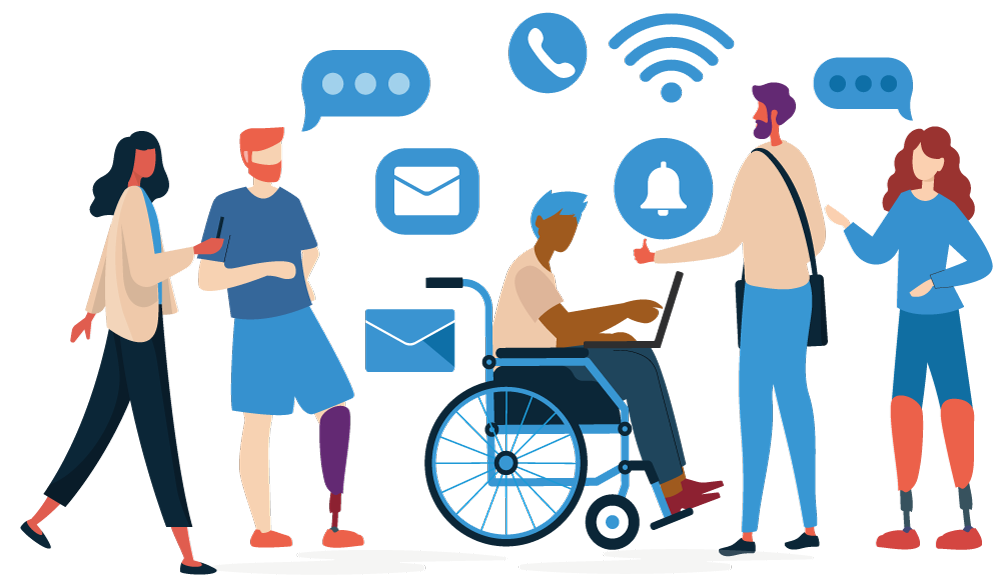
d) Self-learning: ability that enables the employee
obtaining knowledge without the need for constant
guide from the superior, under the employee’s own
initiative, motivation and interest;
e) Balance: Balanced management of work time and the time to enjoy personal life;
f) Digital competence (DC): ability of individuals to use information and communication technologies creatively, critically and safely to achieve objectives related to work, employability, learning, use of leisure time, inclusion and participation in society.
The telework model will last as long as the company considers convenient and which may be modified at any time prior communication to the employees.
Considering that the company currently provides its employees with connectivity through an unlimited data plan (value incurred by the company by granting the plan and which is not paid directly to the employees, the Company will additionally recognize the value of electric energy service consumed by the employees’ work tools, under the concept of teleworking Allowance in accordance with the applicable policies in force). Additionally, the company has an employee plan benefit available for employees to acquire fixed services, which must be used and requested in accordance with the policies in force.
Parental leave
(Content GRI 401-3).
In the year 2022, a total of 57 women had the right to maternity leave and 66 men had the right to paternity leave, and 58 women and 69 men returned to work in year 2022 after parental leave, this could have begun in the year 2021 or 2022. Likewise, 45 women and 64 men returned to work after parental leave. 15 women are still on maternity leave. The return and retention rates of employees who took parental leave were 100% for both women and men.
Training and performance
(GRI Contenido 404-1 y 404-2)
The Company has a training policy that includes the continuous updating of all employees. During the year 2022, Agile training was reinforced through the Lean Agile Academy, reaching all the people who are part of the company. Likewise, It was given a particular focus on specialized agile roles such as Scrum Master, which developed an internal bootcamp, and Product Owner (PO) besides, it produced a unique training model.
Also, it was prioritized digital profiles by incorporating training through the UDEMY platform in which more than 340 training paths were designed covering digital skills ranging from BI to Technology. In this respect were implemented the platform specific training programs for: BI, Digital Relationship, Systems, Technology, People, Processes, B2C and B2B.
We also worked together with Camacoes providing specialized training in digital topics such as UX and UI design.
Time flexibility and teleworking
Through the A la Carte Development program were provided unique and personalized training opportunities in several areas aimed at the continuous development of the personnel in current topics.
The company implemented a training needs detection website that allows leaders throughout the year to share the knowledge needs of their teams in order to close knowledge gaps in a simple and agile way.
The School of Finance was designed and implemented for the entire management. This school focuses on the digitalization of the practice and automation of processes. Providing updated profiles with greater employability.
We conducted two weeks of continuous updates for the entire company: CX Week, focused on customer experience issues, and Digital Week focused on digital issues.
In addition, we continued with ongoing training in languages, collaboration tools, IT tools and best practices.
The average number of hours per employee was 37.6. For men, the average was 33.8 and for women 42.1. However, analyzing by position level, the individual contributor had an average number of hours of 37.9; in middle management it was 35.7 and in the Valora level (Managers) it was 17.8.

The Company also has the DesarrollaT program, which offers a wide range of courses to enhance the development of professional and personal skills, based on three main axes:

Each course has a series of workshops to participate in openly, whoever is interested can register, without limit of courses to take, it can be through a Webinar or select from the E-Learning offer.
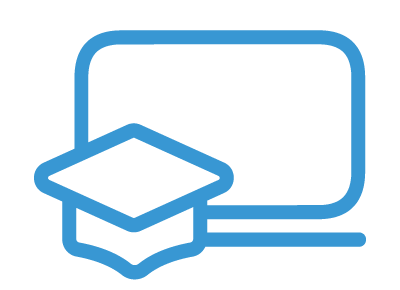
There is also a broad offer of training programs at Universitas (Corporate University), which includes high-level workshops, open to anyone who wishes to enroll in these programs
These training programs are designed for all personnel, regardless of their position.
Responsible for Employee Health and Safety
(GRI Contents 403-1, 403-2, 403-5,
403-6, 403-7, 403-8 and 403-9)
The Occupational Health and Safety Management System (OHSMS) is designed, developed, implemented and monitored for compliance under the highlevel structure of the international standard ISO 45001 version 2018, likewise fully embedded and complimentary to the particular legal requirements for Colombia.
There is a process for identifying the legal requirements applicable to the organization, where was evidenced the compliance with all of them in the annual verification performed. A total of 299 legal requirements were identified in 198 standards, grouped in 23 general topics.
The OSHMS covers 100% of employees, activities and workplaces for each of the cities where the company operates nationwide. The partners’ employees are included in the Responsible Partners program.
The Company performs the process for the identification of hazards, evaluation and assessment of risks under the methodology of the Colombian Technical Guide GTC45 version 2012, where the Similar Exposure Groups are grouped and where each of the activities performed by employees are contemplated with the following classification:
Classification of the main risks by Type of Charges

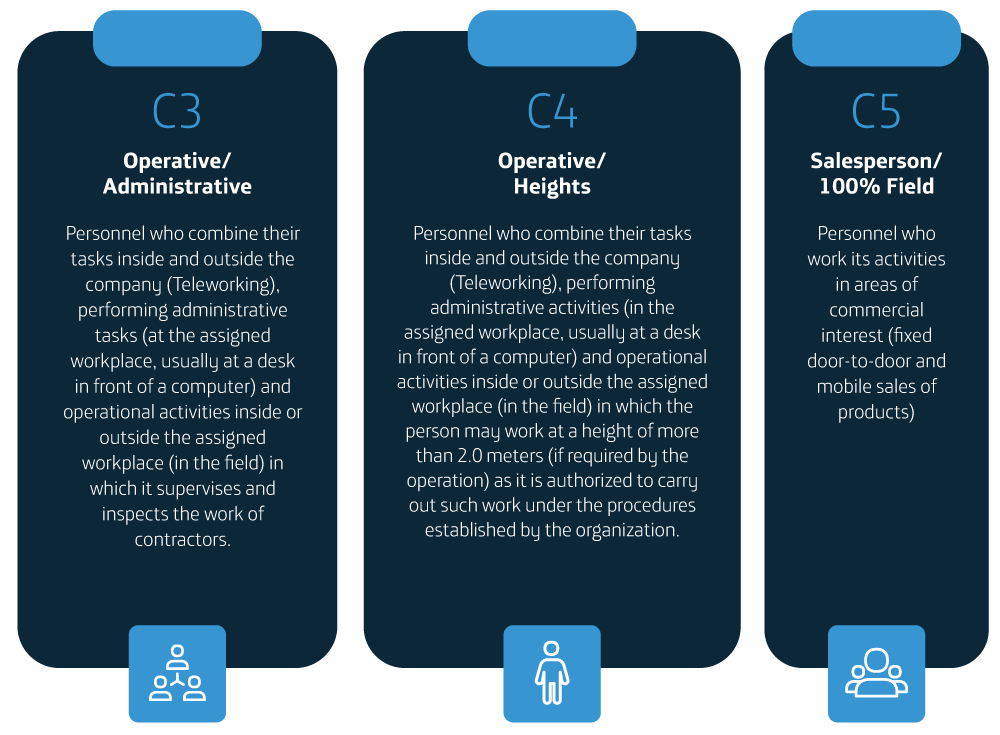

In this sense, the hazard identification, evaluation
and risk assessment matrix is the tool used to
evaluate and prioritize the risks to which employees
are exposed, and within this tool, we describe the
activities to be performed, sorting them by each of
the categories of the control hierarchy.
This matrix is the main entry of the Occupational
Health and Safety Management System, since according
to the results achieved in the evaluation and
assessment process are identified the priority risks
that management programs need or epidemiological
surveillance systems that allow the reduction of the
exposure of employees to risk factors that have the
potential to generate occupational accidents or
occupational diseases.
In this sense, the matrix should be updated as follows:
- At least once a year
- When a serious or fatal work accident occurs.
- When the risk is evidenced in an inspection and has a high potential to generate harm to people.
- When a work accident occurs and the risks that generated it were not identified.
- New legal requirements or amendments to existing requirements impacting the OSHMS.

Now, the participation of workers in the process of notification of hazards or hazardous situations is done through the report of the observations submitted by employees in the deployments of the OSHMS, the report of unsafe acts and conditions, communications sent to the Joint Committee on Occupational Safety and Health.
Employees have a very important role within the Occupational Health and Safety Management System, therefore, their participation is permanent in each of the components of the System. In this sense, it is important to emphasize that no employee is forced to work under unsafe conditions that compromise their safety or health.
Occupational accidents are investigated under a specific methodology for Colombia, which considers the type of event that occurred, the hazards and risks involved in the event, applies the “5W+1H” methodology to set a clear description of the event, collects all the information associated with the occurrence of the event, under all the verification of the information and description is performed a causality analysis to conclude with the root cause or the causes of the event and take corrective actions for the correction and prevention of nonrepetition of the event.

Occupational and preventive medicine
The occupational and preventive medicine process of
the OSHMS focuses on occupational medical
examinations, follow-up of medical cases,
qualification of origin processes, absenteeism due
to medical causes and indicators of prevalence and
incidence of occupational disease.
The mechanism for employee participation and
consultancy are as follows:
- Joint Occupational Health and Safety Committee
- Labor Coexistence Committee
- Road Safety Committee
- Management review
- Internal Customer - Remedy
- Reporting of absences due to health reasons
- Report of health conditions
- Bussiness Partner, OSH team, management and regional leaders
- Lives, campaigns and notes
- Participation to identify hazards related to the role
- SST Training
- Participation in eNPS measurements, Employee, culture, and experience
The Joint Occupational Health and Safety Committee is a body formed by workers’ representatives who are elected by a national vote and by the employer who are appointed by the senior management representative, whose main function is to preserve permanent communication of the needs and results of the OSHMS. The committee holds regular monthly meetings and, if required, it holds extraordinary meetings.

Occupational health and safety training for workers
In 2022 they conducted 553 training
sessions equivalent to
51.333 hours.
Within the courses, the following can be emphasized:
- Overview of the Occupational Health and Safety Management System and the Environmental Management System
- Basic OSHMS Course
- Course Recomenzamos Prevención COVID-19 COL
- Safe mobility, road safety and risks on the street and roads in PAP
- Prevention of behaviors that affect labor harmony
Health promotion and prevention and mitigation of OSH impacts
In Telefónica Movistar all employees are affiliated to health promoting entities from the moment they join the Company, as well as health promotion and prevention activities are carried out based on the results of the health condition reports, the results of absenteeism due to medical reasons. Health promotion and prevention activities are also conducted based on the results of the health condition reports, and are held on-site and virtual activities with the purpose to promote the participation of employees.
There is a matrix for the identification of hazards, evaluation and risk assessment of exposure groups C2 and C5, as well as specific actions for the employees of the commercial areas as part of the system deployment activities.
Work-related injuries
Although in 2022 the Company did not have any fatalities in operations, there were two events with major consequences for a rate of 0.1789. Likewise, there were 52 events of occupational injuries for a rate of 4.6535. The total number of man-hours worked was 11,174,280.
In the case of workers who are not employees, there were no fatalities, however, they did have 18 events with major consequences (rate of 1.0706) and 300 recordable occupational injury events for a rate of 17.84. The total number of man-hours worked was 16,812,192.
In both workers and non-workers, the most frequent types of accidents included: fractures, sprains, strains, muscle tears, muscle or tendon herniation or laceration without injury, internal concussion or trauma, blows, contusions or crushing.
The occupational hazards that report a risk of injury from occupational accidents with major consequences are determined in the hazard identification, evaluation and risk assessment tool, where they are prioritized and determined by a risk management program or an epidemiological surveillance system focused on the reduction of the accident rate, with the implementation of intervention measures by risk control hierarchy.
The hazards that have caused or contributed to the injuries were: occupational hazards due to work at heights, due to travel, and road hazards. The rates were calculated per 1,000,000 hours worked.
Occupational diseases and illnesses
Neither for employees nor for non-employees have any deaths been reported. However, in operations, there is one case of recordable occupational disease with Osteomuscular – Carpal Tunnel bilateral in a worker.
5.3.3 Human Rights
(GRI Content 2-23)
- Telefónica Movistar recognizes and acts in line with high standards and international conventions on human rights.
Defining corporate policies where Human Rights issues are integrated: the Responsible Business Principles – PNR (or Code of Ethics) include the company’s commitment to respect Human Rights. This commitment extends from its employees to its commercial and operational partners from the moment it formalizes the commercial relationship with the company. Similarly, in 2019 the Human Rights Policy was launched, aligned with the Responsible Business Principles and transversal to other corporate policies related to respect for Human Rights such as gender equality; people with disabilities; diversity and inclusion; sustainability in the supply chain; the protocol for relations with communities; and the set of procedures that consolidate the labor policy. Telefónica’s commitment to the respect and promotion of Human Rights has been developed in the areas that cover its scope of influence and in its relationship with employees, suppliers, customers and society in general, which is materialized in the following commitments
Commitment to the customer:
Commitment to employees:
Commitment to society:
Commitment to respect
human rights in the supply chain and in relations with business partners.
Remediation of negative impacts
(GRI Content 2-25)
Strengthening the incorporation of the human rights approach in the complaint and claims mechanism regarding human rights.
In the Company’s operation, due diligence is mainly focused on the promotion and application of the Human Rights policy, impact risk assessments, integration of Human Rights transversally in the processes, and the establishment of the complaints and claims mechanism attentive to Human Rights to foster the relationship with stakeholders.
The Company identifies and manages human rights risks arising from the operation, and continues to monitor the effectiveness of the response to identified human rights risks through indicators and action plans. The company continues to implement the Corporate Risk Management Manual and, by virtue of this, performs a human rights risk analysis that is updated quarterly. The main risks identified related to the development of the operation and those of suppliers were: 1) network deployment, 2) conditions of products and services, 3) use and management of data and new technologies related to artificial intelligence, and 4) conditions and new work models.
In 2022, we continued to monitor civil works complaints not related to the service, in order to ensure that the responses to the PCC received through the channel were aligned to the type of HR impact, and that the solutions provided to the situations reported will be carried out within the maximum legal timeframe established. During the year, the main situations reported were related to situations derived from network deployment actions.
Human rights are a material issue for Movistar. For this reason, the company has advanced in the development of actions that contribute to their management, following and monitoring their impact, through the implementation of a due diligence process on Human Rights, as established by the Guiding Principles on Business and Human Rights of the United Nations. In line with these principles, Telefónica Movistar is responsible for respecting the human rights of all its internal and external stakeholders in the development of its operations. Although this responsibility is complementary to the State’s obligation to protect these rights, the company is not exempted from ensuring it when the State and/or the national legal framework do not comply with this responsibility.
Telefónica Movistar recognizes and acts in line with high standards and international conventions on human rights. Defining corporate policies where Human Rights issues are integrated: Telefónica’s Responsible
Business Principles – PNR (or Code of Ethics) include the company’s commitment to respect HR. This commitment extends from its employees to its commercial and operational partners from the moment it formalizes the business relationship with the company.
Similarly, in 2019 the Human Rights Policy was launched, aligned with the Responsible Business Principles and transversal to other corporate policies related to respect for Human Rights such as gender equality; people with disabilities; diversity and inclusion; sustainability in the supply chain; the protocol for relations with communities; and the set of procedures that consolidate the labor policy.
The telecommunications sector and new technologies today play an important role in the promotion of human rights, since diligent management can contribute to the progress of countries and improve people’s quality of life. However, this new context and the accelerated use of technology bring with them a series of challenges associated with privacy, freedom of expression, equality and employment. Therefore, in an increasingly digitized world, today the company’s challenges lie in ensuring that human rights are also guaranteed in the digital environment.
Telefónica Movistar Colombia seeks to promote and preserve the welfare of the social environments in which it operates, therefore, it has been managing human rights since 2009 by applying the principles of due diligence in its processes, in order to identify, prevent and manage potential risks of human rights violations.
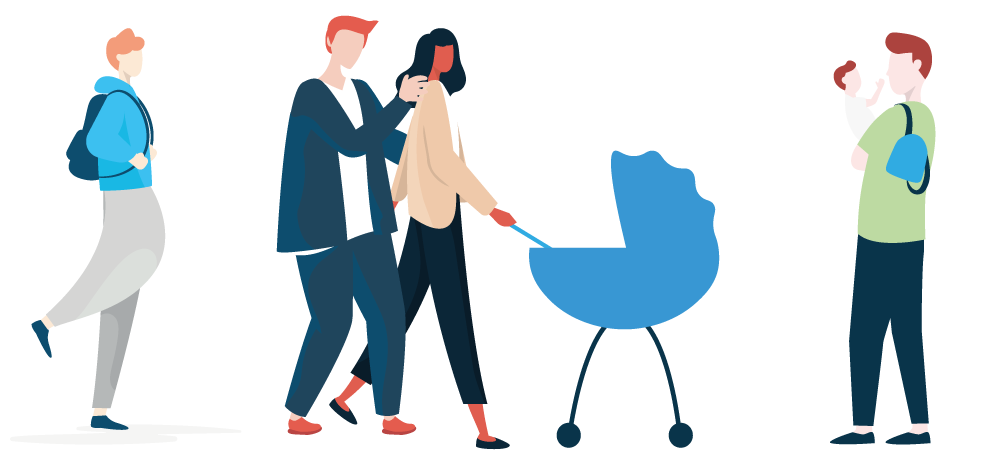
A key factor for the management of Human Rights is focused on continuous participation and updates in opportunities for dialogue and knowledge management in this area, for this reason, the company remained involved in 2022 in initiatives that promote the responsible management of Human Rights in business environments:
- Telefónica Movistar Colombia is still an active partner and member of the multi-actor initiative Colombian Guides in Human Rights (HR) and International Humanitarian Law (IHL); within the framework of this initiative, the following activities were carried out in 2022:
- Preparation of a new Colombian Guide focused on climate change and fair transition: currently, there is a complete draft of the Guide, which will be launched in 2023.
- ECO territorial: it was held a Meeting with SMEs in Cali, about challenges and opportunities to promote due diligence in HR for SMEs.
- Monthly workshops: participation in eleven (11) monthly workshops to provide an exchange and feedback on the content of the initiative.
- Movistar participated as a speaker in the Annual Event Guías Colombia: Strengthening the business management of human rights from the regions, with the participation of different types of actors.
Telefónica Movistar Colombia implemented the Self-diagnosis Tool of the Supply Chain guide. The objective was to understand the progress made in the management of human rights due diligence in the supply chain and Partners, identifying opportunities for improvement to align areas and internal programs to strengthen this management. Overall, the company achieved 99% progress in the implementation of the Guide. It pointed out, in particular, improved progress in the implementation of the cross-cutting due diligence guidelines and in the “Organizational Management of the Supply Chain” component.
(GRI Content 412-1)

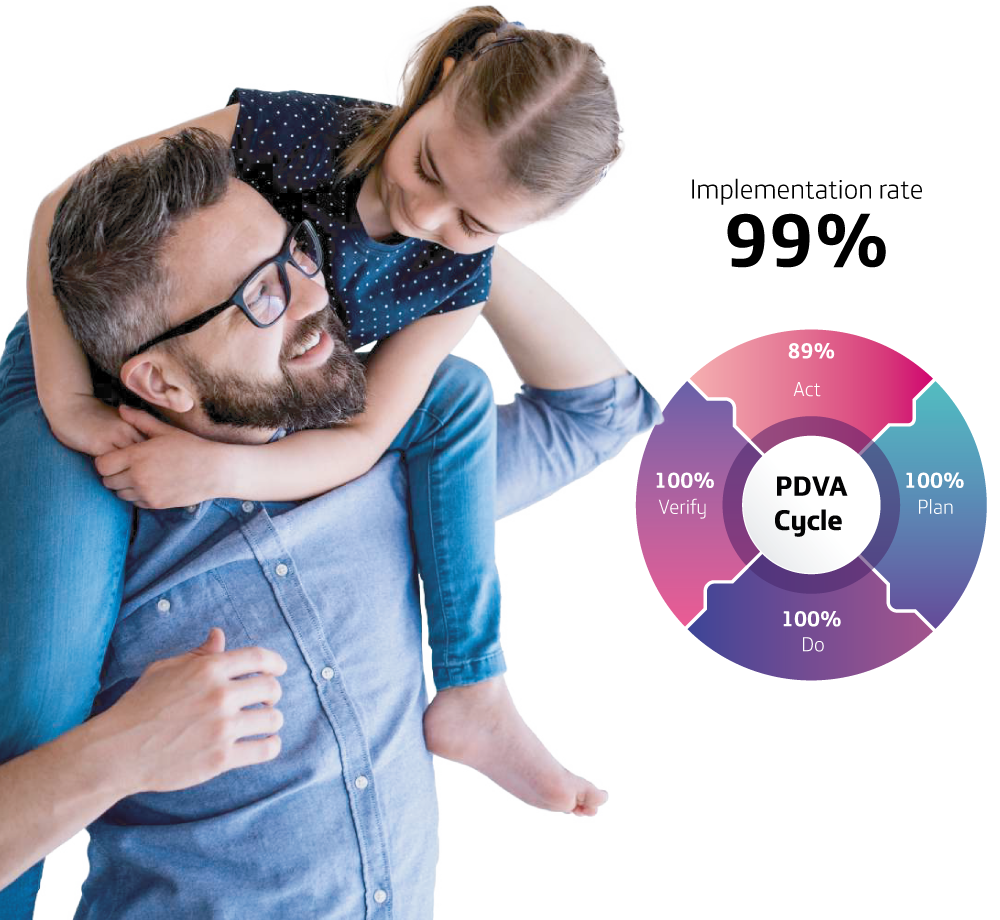
- Executive participation in the Enterprise and Development Committee sponsored by the Spanish Embassy in Colombia, a meeting and dialogue area for Spanish companies operating in Colombia in the fields of sustainable development and human rights, to agree on working guidelines to advance in the development of corporate social responsibility actions and compliance with due diligence in human rights.
- Participation in the Global Compact’s Human Rights Roundtable, the company reported its comprehensive human rights program:

Training on Human Rights
(GRI 410-1, 412-2)
The current arrangement of Security for the protection of the people, properties and infrastructure of Telefónica Movistar Colombia is assigned to the partner companies SEGURIDAD ATLAS LTDA, PROSEGUR S.A. CÍA. DE SEGURIDAD and HONOR SERVICIOS DE SEGURIDAD LTDA.
The following are the details on Human Rights training for the personnel of each of them assigned to the security scheme:

According to the distribution of the personnel of each of the partners companies, the total percentage of training in Human Rights of the Security personnel assigned to the protection of people, goods and infrastructure of Telefónica Movistar is 84%

